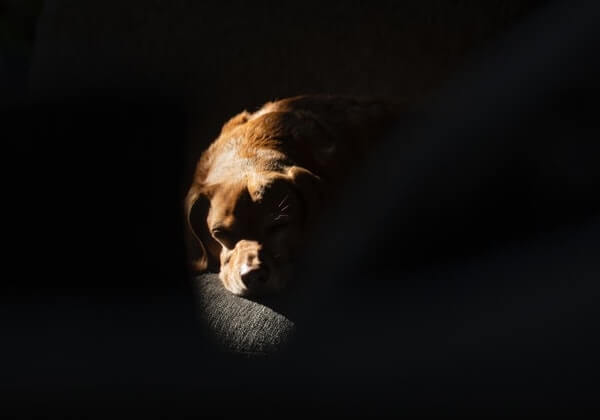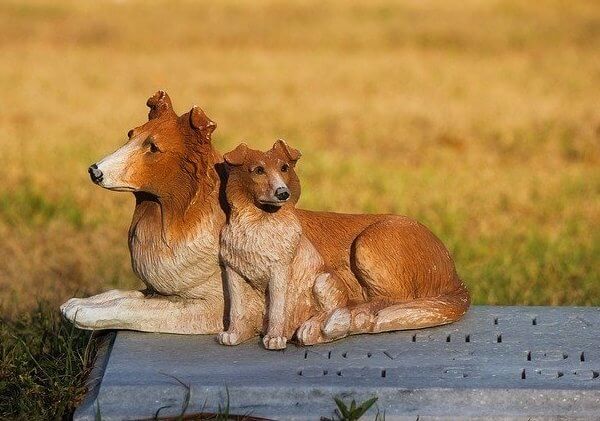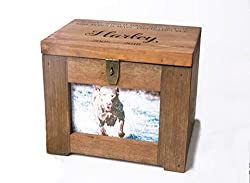
How long does it take for a buried dog to decompose? It takes an average of 6 months to 18 years for a buried dog to decompose fully. If a dog is exposed and not buried, it will decompose much more quickly. The speed at which a dog decomposes depends on how deep you buried him, the climate/temperature, moisture, soil type and acidity, body mass, material of the coffin or covering, and if his body is enclosed or exposed.
Dogs are adorable pets. The sad news is that, just like humans, dogs do pass away. A dog’s death can be caused by various factors such as illnesses, accidents, old age, or going without water for long periods of time to name a few. When they pass away, it’s important that we know what to do next.
To help you make the best, most informed decision about the dog burial process, we’ve provided valuable information and answers to all your questions on how to handle a dead dog and what goes on through the decomposition process when a dog pass away.
Table of Contents
How long does it take for a buried dog to decompose?

Depending on various factors, the buried dog decomposes fully (dry bones stage), for an average of 6 months to 18 years.
The decomposition process taking place underground is determined by various factors. For example:
- The depth at which the carcass is buried.
- Burial method. For example; lay the carcass in the grave and pour soil directly over it, covered by a piece of cloth or blanket, put in a coffin, or put in a plastic bag.
- Climate and temperature. It’s also a major factor to consider. If your area is hot, the carcass is likely to decompose faster compared to the cold areas.
- Age. The younger the dog, the faster it decomposes compared to adult and old dogs.
- Breed. The larger the body the longer it takes to fully decompose unlike the ones with smaller body size.
READ ALSO: How Long Does It Take For Dog Poop To Decompose?
5 factors that determine how long it takes a Buried Dog To Decompose
1. Material of the wrapping or coffin
According to researchers Mark Guillon and H. Duday, in the book titled Forensic Anthropology and Medicine, they pointed out that:
“…a body in contact with the ground will decompose more rapidly. Conversely, any covering, such as a coffin or cloth, will impede the process. The material of the covering plays a crucial role; while wooden coffins are biodegradable and thus expedite decomposition, plastic wrappings have the opposite effect, taking anywhere from 20 to 500 years to break down.”
2. Body mass
How big or small something is can really make a difference in how quickly it breaks down.
According to this cool study, authors Ann H. Ross and Amanda R. Hale noted that the size of the body, or its body mass, is one of the things that affects how fast it decays.
So, if something is smaller, it will break down faster than something that’s bigger.
That’s because smaller things have less body mass. For example, a small dog will break down faster than a big dog because it’s smaller.
3. Temperature
The climate and temperature significantly influence the rate at which a body decomposes.
In warmer climates, decomposition occurs more quickly due to the increased activity of bacteria and insects that break down the carcass.
Conversely, the decomposition process can slow down or even halt entirely in colder or drier environments, resulting in mummification.
This is because bacteria and insects are less active in such conditions, slowing down the breakdown of the carcass.
4. Soil
The soil type in a specific area can affect how quickly something breaks down.
This depends on a few things:
- What kind of soil it is.
- How acidic or basic it is (that’s the pH level).
- How wet or dry it is.
Type of Soil
- Sandy soil can help speed up the process of breaking things down.
- Clay soil can slow things down because it’s more compact and dense, making it harder for air to move around. And just like us, bacteria need air to live and do their job.
pH Level
The acidity of the soil can also make a difference. If the soil is too acidic (with a pH level under 6.0), it can cause bacteria to be less active.
And since bacteria help break down stuff in the ground, if they’re not working as much, things can take much longer to break down.
Moisture Content
The amount of water in the soil also plays a role. Normal levels of moisture help speed up the process. But if there’s too much water, it can actually slow things down because the water takes up space that would normally be filled with air.
And remember, bacteria need air to do their job. So, if there’s too much water, it can make it harder for the bacteria to break things down.
5. Depth of the grave
Here’s a simple rule to remember: the deeper a dog is buried, the longer it takes to break down. That’s because it’s colder underground, and there’s not as much air.
Just like how you might feel slow and sluggish when you’re cold, bacteria – the tiny creatures that help break things down – don’t work as well in the cold either.
And just like how you need air to breathe, bacteria need air to do their job.
So, when it’s cold and there’s not much air, the bacteria can’t break things down as quickly.
How long does it take for a dog to decompose above ground?
It takes an average of 3 to 6 months for a dead dog to fully decompose if left above ground. Generally, a dog will decompose 8 times faster when left above ground than when they are buried.
If you are a pet parent, you can agree with me on this.
You consider your dog as family. And you are more than willing to do all that it takes to keep them around and healthy. When nature calls, there isn’t much you can do to prevent the worst from happening.
Finding a dog lying on the ground dead and just decomposing in the open is uncommon. If this is the case, it could be due to one of two reasons.
First, maybe the dog did not have a permanent home or anyone who ever took care of it when it was alive.
Second, maybe the dog was taking a walk by itself, got in an accident and never made it home nor got any medical attention that he needs. Making the matter worse, maybe dragged to the nearest bush and the owner never gets to know it’s whereabouts.
And just like that, you start smelling something rotten from your neighborhood or when using the road.
Now is the time to start digging deep on how long you are going to keep up with the unbearable stinky smell you are not sure how to control.
Starting from the 3rd to the 14th day, things are going to be tough! It will even worsen when it’s sunny! The smell is going to be very strong.
Plus the flies are going to be all over the place. Starting from the carcass to some few meters away!
But, worry not because nature has a way of resolving itself. Your situation might be relieved maybe even before the 14 days elapses.
Scavengers might come picking on the flesh, flies, maggots, and maybe rain. And the situation gets resolved by itself.
Once all the flesh is dissolved, dry bones don’t smell.
DON’T MISS: Chihuahua Health Issues (Complete Guide)
How long does it take for a dog to decompose underground?

Unlike a dead dog that is left exposed above ground, underground decomposition takes longer. Depending on a number of factors, the carcass to fully undergo the decomposition process can take an average of 6 months to 18 years.
Here are the possible factors which can enable the carcass the decompose within a period of 6 months to 1 year:
- Buried on a maximum of three feet down the ground.
- Buried on bare soil, no blanket covering, carton box, nothing.
- Normal climatic temperature.
If buried deeper, blanket-covered, in a carton box, coffin, or using a plastic bag. It takes 2-18 years to fully decompose.
RELATED: Can A Dog Get Parvo Twice?
How long does it take for a buried dog to decompose in a sealed box?
The duration of between 6 months to 2 years is enough for a dead dog buried in a box to fully decompose.
As compared to bare burial, box burial can take a little bit longer. But the difference is not much given a box breaks easily.
How Your Dog Decompose
Did you know that decomposition kicks off immediately when the dog pass away?
Now you know.
The moment blood circulation stops around the dog’s body that is the moment the decomposition process takes over.
The first stage is not visible nor does any smell come out.
The smell will start to be noticed between 10 – 78 hours after death.
The Decomposition stages include:
- Fresh
- Bloat
- Active decay
- Advanced decay
- Dry bones
Let’s discuss each of these stages in details.
READ NEXT: Fat Chihuahua (How To Slim Down An Obese Chihuahua)
5 Stages of decomposition in a dog

The only way you will be able to see all the five stages go down, is when the carcass is left above the ground.
1. Fresh
Once the blood stops pumping, it starts to get cold, making the start of decomposition. Within three (3) to six (6) hours after death, the blood starts to drain towards the area of pressure (where it’s lying on). It can be the belly, back, or head.
The flies are most likely the ones to arrive first and will feed on the blood and flesh. They will also lay eggs which can be dangerous to other animals nearby if the dead body isn’t taken care of properly.
To avoid this, make sure to bury your beloved deceased dog immediately. This will help avoid all the flies and maggots from being attracted to your decease dog’s body.
RECOMMENDED: White Specks in Dog Poop (Not Moving): What Should You Do?
2. Bloat
Bloating looks like swelling. This usually occurs 4 to 10 days after your dog’s death.
It appears that the dead dog’s body increases in size.
During this stage, the bacteria will play a part in breaking down the tissues. Once this process starts, the gases in the carcass build up and eventually cause the fluids to push out of the dead body.
Now the smell is at its peak. If the carcass is left above the ground, anything which feeds on the carcass will be invited by the smell, including animals and insects.
3. Active Decay
During the active decay stage, which is about 10 to 20 days after your dog pass away, his or her body will start to shrink. The size of the carcass will reduce from being inflated.
As a result, the rotten smell will start to fade away slowly as well.
Why is that?
Because the fluids inside the body will have been evaporated or are nearly emptied and will soon be absorbed by the surrounding soil, leading to a decrease in the odor.
Since blood is gone, only minimal flesh is left. The only things left are flies and maggots feeding any last piece of flesh.
4. Advanced Decay
The advanced decay takes place 20 to 50 days after your dog’s death.
Most of the decomposition process has taken place. This mean that most, if not all, of their flesh will be gone during this stage.
The only things remaining would be their fur and dry bones.
The flies and maggots will be gone by the end of this stage.
If the carcass was lying on the grass, it’s also dried by now, along with the grass and soil underneath and around it. You may start to see mold surrounding the bones and fur.
While the carcass is dried, the remaining bones and fur may emit an odor that’s similar to spoiled milk. This is caused by butyric acid.
And with any unpleasant smell, it will draw in different organisms.
DON’T MISS: Can Dogs Eat Spoiled Meat? The Dangerous Truth!
5. Dry Remains
This stage marks the end of the decomposition process. The only things left are dried bones, cartilage, and dried skin.
As the days pass, even the cartilage, dried skin, remnants of fur, and dried bones will be decomposed by tineid moths and bacteria.
Note: If the carcass is buried, there will be no flies and scavengers which means the decomposition process is longer. Maggots are the ones that do the flesh breaking down process.
How long can you wait to bury a dog?
After death, waiting 2 to 3 hours is enough if you touch and feel the body is already cold. This confirms the decomposition process has taken off.
If you wait more than 3 hours, the flies will start settling on the dead dog. And a few hours later (10 to 12 hours), the carcass will start to produce a rotten smell if the climate is warm or hot.
If you want to avoid this, it’s best to conduct the burial process sooner rather than later.
CHECK OUT: French Bulldog Lifespan (How Long Do Frenchies Live?)
How long does it take for a dead dog to smell?

It depends on various factors. Let’s talk about temperature. If it’s snowing or cold where you live and the dead dog is outside, the carcass will not have any smell. In a warmer climate, the smell will start becoming noticeable between 10 to 12 hours after death.
Under normal temperature, the awful rotten smell will be all-over the place within 24 to 48 hours.
Keeping a carcass in your house is the worst idea ever! You are inviting all kinds of flies and pests which can spread serious disease.
The best you can do to keep your dead dog around the house henceforth, is to settle for cremation.
How deep should you bury a dog?
The standard depth for a dog grave is two feet deep. But if the selected spot is 90+% sand. The depth can be increased up to three feet.
The reason you are taking the effort to bury the dog is to prevent the unbearable smell the carcass will have from affecting your daily activities. Plus ensure a proper decomposition process.
Then comes the need of doing it right:
- To prevent it from being dug up by animals.
- Prevent breaking any underground pipes.
- Find the right materials to cover the grave. It’s necessary to ensure the grave is not disturbed.
- Fill the top 5 to 8 inches with small stones. If you wish to, you can construct a concrete slab on top.
Where is the best place to bury a dog?
When selecting the best spot to lay your pet to rest, it is important to take your time in selecting an area that you are sure will not be dug up in the near future.
You need to ensure the spot is not near any pipes or wires. Plus, it should be a safe distance from a water source.
Also, it should be some reasonable distance from the flowerbed, since flowers need to be taken care of more often.
Will a buried dog smell?
Yes, a buried dog does smell, but unlike a carcass left above ground, a buried dog does not smell all over the place. Also, the remains do not get picked up by flies, birds, and animals.
What animal would dig up a dead dog?
The most common animals that would dig up dead dogs include fox, bear, wolf and badger.
It’s not only heartbreaking, but it can be traumatizing finding the precious dog you buried being dug up to the surface by an animal and their remains being scattered all over the place.
Or you find the grave open, and the dog you buried has been taken away or stolen.
That is why when you decide to bury your dog, it is best to take all the necessary precautions. To ensure the process turns out to be a success.
The most important steps are:
- Dig the grave deep enough so it’s harder to dip up. Two to three feet deep is recommended.
- Cover the grave properly. Preferably with stones or slabs.
Considerations for burying your pet
Now that you are in a situation to decide whether to bury your pet or not, here is a list of ideas to help you make an informed decision.
1. Cremation
Are you an environmental keeper? If your answer is yes. We are on the same boat. Let’s keep sailing.
Burying your dead pet in the yard can not only be a tedious process but also comes with lots of precautions to take. Here comes the simple way out: Cremation. This will also grant you the opportunity to feel close to your pooch.
Cremation: You won’t need to worry about anything. All you need is to sit tight and let the carcass get reduced into ashes.
This process does not contaminate the environment. You won’t have any future regrets when you want to move to a new home. All you will need is to pack your belongings and bring your cremated urn along.
2. Safety
Before making any decision, you need to put in place all the safety measures ahead of anything else.
Before starting to dig deep down the ground. It’s best if you first let the authority know.
Once granted a go-ahead, you can comfortably go ahead with your plans without worrying that you might end up in trouble or even worse hurting yourself. For example, you accidentally land on an electric wire. Or gas pipe to name a few.
3. Depth
Maybe your tradition or religion does not allow cremation. Worry not, as I promised earlier, I am here to help each and everyone who lands on our website to find a solution and answer what you are looking for.
Once you have decided on the perfect spot to bury your pet, make sure to dig deep enough. At least two feet deep. It’s best to make it three feet if possible if your dog breed is big, such as a bulldog.
Do not forget to cover the grave properly. Preferably with stones or a slab. It helps to minimize the disturbance of the grave.
4. Location
Are you wondering what location has to do with you burying your pet?
Well, it’s very important to take note of a particular location around your house or apartment that is dry and high if any. Selecting a place where rainwater settles or a swampy area can easily lead to underground water contamination.
If the grave area soaks wet, the possibility of contaminating underground water is very high. Thus poisoning the environment.
5 Reasons why burying a dog in your backyard is a bad idea
Burying your dog in the backyard can seem like the easy and the fastest way to quickly bury the carcass.
But, did you know that one of the riskiest ways to deposit a carcass, is to dig up the soil and just put it inside? Little do they know, it’s a very bad idea. Here’s why:
1. The Carcass Being Dug Up
It will be to your surprise, when you wake up one morning only to find the remains of the dog you buried, scattered all-over the place around your yard.
Animals like foxes are good at such a job. Especially if you didn’t bury the carcass deep enough, at least two feet deep plus cover the grave properly.
If your pet had a medical condition that led to the death, you can guess what’s coming your way especially if the condition was contagious!
2. Flooding
Underground contamination can be the worst contamination ever because it can affect a very wide area. Plus the reason for contamination can take longer to be detected.
A number of pets can easily get contaminated. It will even get worse if humans get an infection.
To be each other’s keeper, please let’s take all the necessary precautions to facilitate healthy living.
Let’s avoid to bury carcasses in any area where flood water often affects.
3. Law
Before you go ahead and bury your pet in the backyard. It’s best for you to know that in the US, some states do not allow home pet burial.
Whereas some states do allow, but you need approval from the authority and you need to comply with all the rules and regulations put in place.
4. Leaving Your Pet Behind
There may be situations where you need to relocate. And you already buried your dog in the backyard. You will have to cope with the situation of letting your dog go by leaving them behind. This is definitely not an easy thing to come to terms with.
5. Resurfacing
Getting to a situation where you find the carcass of the dog you buried surfaced and being swept away with heavy rainwater can be a nightmare.
It is very possible especially if the grave is shallow such as just below two feet deep.
As well it can cause water contamination and spread an infection.
5 Alternatives to burying your pet in the backyard
Who does not like it when given an alternative to work in a given situation? As for me, I love having alternatives to solving a problem. It gives an option to make a decision. Thus relieving the situation a little bit.
Let’s dive in to the alternatives of burying your pet in the backyard.
- Outdoor urn (rock). It’s okay if you want to go for the cremation option but you don’t like it one bit to keep the cremains in your house. There is an option for you to get an outdoor urn (rock), which you can always keep in the backyard.
- Biodegradable urn. The option of having your pet cremated. And having the opportunity to conduct burial for them without contaminating the environment is adorable. Making the idea more awesome, you can spread the ashes on the most memorable spot between you and your pet.
- Pet donation. Would you like your pet to be part of history? Well, you have the best option of donating it to a research institution. It will provide the best opportunity for willing learners in the veterinary profession to enhance their knowledge.
- Pet Cemetery. Finding the best place within your house or apartment to use as a grave spot can be a little difficult. And the only option you’re left with is to settle for the pet cemetery so you can pay your last respect to your adorable pet.
- Alkaline hydrolysis. Using heat, water, and alkaline chemicals, the body will decompose faster than letting nature take its time. The bone fragments cremains will then be given to the dog owner.
Details on US legislation regarding burying dog
Pet burial law varies from state to state. It is best for you to make an inquiry from the authority to be on the safe side of the law before taking any step.
The most common laws under the dog burial include:
- The dead pet is required to be buried within 24-48hrs from the time of death.
- Backyard pet burial must be permitted by the authority. Under the compliance of all the rules and regulations put in place.
- Cemetery pet burial is allowed. Though it can sometimes take longer than 48hrs.
Details on UK Legislation (as of 2013)
Did you know that in the UK, it’s a crime to bury a dog on a rented property?
If you don’t own the property, then you have an option to bury your pet in a registered pet cemetery. Plus the grave depth should be two feet deep if it’s heavy soil and three feet deep for light soil.
There is no carcass disposal anywhere near water sources and no burying of an animal with a contagious condition.
Final Thoughts
At this point, I believe you are better equipped with almost if not all the necessary information on how long you have to wait to bury a dog and how to properly conduct a safe burial process. It will be the best idea for you to go through the post step by step. I trust you will come out with one or two new ideas.
DISCLAIMER: THIS WEBSITE DOES NOT PROVIDE MEDICAL ADVICE
The information, including but not limited to, text, graphics, images and other material contained on this website are for informational purposes only. No material on this site is intended to be a substitute for professional veterinary advice, diagnosis, or treatment. Always seek the advice of your veterinarian or other qualified health care provider with any questions you may have regarding a medical condition.
Resources:
https://www.wikihow.com/Bury-a-Pet

With over five years of specialized experience as an animal writer, my expertise lies in dog nutrition, health, behavior, grooming, and training. I am dedicated to delivering helpful and informative content that caters to the well-being of our furry friends. My primary goal is to empower pet owners with knowledge and ensure our canine companions thrive in health and happiness. In my free time, I love volunteering at local dog rescue centers.










